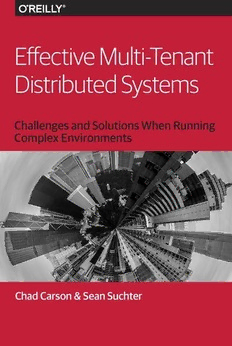
Effective Multi-Tenant Distributed Systems: Challenges and Solutions When Running Complex Environments PDF
Preview Effective Multi-Tenant Distributed Systems: Challenges and Solutions When Running Complex Environments
Effective Multi-Tenant Distributed Systems Challenges and Solutions when Running Complex Environments Chad Carson and Sean Suchter BBeeiijjiinngg BBoossttoonn FFaarrnnhhaamm SSeebbaassttooppooll TTookkyyoo Effective Multi-Tenant Distributed Systems by Chad Carson and Sean Suchter Copyright © 2017 Pepperdata, Inc. All rights reserved. Printed in the United States of America. Published by O’Reilly Media, Inc., 1005 Gravenstein Highway North, Sebastopol, CA 95472. O’Reilly books may be purchased for educational, business, or sales promotional use. Online editions are also available for most titles (http://safaribooksonline.com). For more information, contact our corporate/institutional sales department: 800-998-9938 or [email protected]. Editor: Nicole Taché and Debbie Hardin Interior Designer: David Futato Production Editor: Nicholas Adams Cover Designer: Randy Comer Copyeditor: Octal Publishing Inc. Illustrator: Rebecca Demarest October 2016: First Edition Revision History for the First Edition 2016-10-10: First Release The O’Reilly logo is a registered trademark of O’Reilly Media, Inc. Effective Multi- Tenant Distributed Systems, the cover image, and related trade dress are trademarks of O’Reilly Media, Inc. While the publisher and the authors have used good faith efforts to ensure that the information and instructions contained in this work are accurate, the publisher and the authors disclaim all responsibility for errors or omissions, including without limitation responsibility for damages resulting from the use of or reliance on this work. Use of the information and instructions contained in this work is at your own risk. If any code samples or other technology this work contains or describes is sub‐ ject to open source licenses or the intellectual property rights of others, it is your responsibility to ensure that your use thereof complies with such licenses and/or rights. 978-1-491-96183-4 [LSI] Table of Contents 1. Introduction to Multi-Tenant Distributed Systems. . . . . . . . . . . . . . . . 1 The Benefits of Distributed Systems 1 Performance Problems in Distributed Systems 1 Lack of Visibility Within Multi-Tenant Distributed Systems 4 The Impact on Business from Performance Problems 4 Scope of This Book 6 2. Scheduling in Distributed Systems. . . . . . . . . . . . . . . . . . . . . . . . . . . . . 9 Introduction 9 Dominant Resource Fairness Scheduling 10 Aggressive Scheduling for Busy Queues 12 Special Scheduling Treatment for Small Jobs 13 Workload-Specific Scheduling Considerations 14 Inefficiencies in Scheduling 16 Summary 22 3. CPU Performance Considerations. . . . . . . . . . . . . . . . . . . . . . . . . . . . . 25 Introduction 25 Algorithm Efficiency 26 Kernel Scheduling 27 I/O Waiting and CPU Cache Impacts 30 Summary 32 4. Memory Usage in Distributed Systems. . . . . . . . . . . . . . . . . . . . . . . . . 33 Introduction 33 Physical Versus Virtual Memory 33 Node Thrashing 34 iii Kernel Out-Of-Memory Killer 37 Implications of Memory-Intensive Workloads for Multi- Tenant Distributed Systems 38 Summary 41 5. Disk Performance: Identifying and Eliminating Bottlenecks. . . . . . 43 Introduction 43 Overview of Disk Performance Limits 45 Disk Behavior When Using Multiple Disks 46 Disk Performance in Multi-Tenant Distributed Systems 47 Controlling Disk I/O Usage to Improve Performance for High-Priority Applications 48 Solid-State Drives and Distributed Systems 50 Measuring Performance and Diagnosing Problems 52 Summary 54 6. Network Performance Limits: Causes and Solutions. . . . . . . . . . . . . 55 Introduction 55 Bandwidth Problems in Distributed Systems 55 Other Network-Related Bottlenecks and Problems 61 Measuring Network Performance and Debugging Problems 62 Summary 64 7. Other Bottlenecks in Distributed Systems. . . . . . . . . . . . . . . . . . . . . . 67 Introduction 67 NameNode Contention 67 ResourceManager Contention 69 ZooKeeper 70 Locks 71 External Databases and Related Systems 72 DNS Servers 72 Summary 73 8. Monitoring Performance: Challenges and Solutions. . . . . . . . . . . . . 75 Introduction 75 Why Monitor? 76 What to Monitor 78 Systems and Performance Aspects of Monitoring 80 Algorithmic and Logical Aspects of Monitoring 85 Measuring the Effect of Attempted Improvements 88 Allocating Cluster Costs Across Tenants 89 iv | Table of Contents Summary 90 9. Conclusion: Performance Challenges and Solutions for Effective Multi-Tenant Distributed Systems. . . . . . . . . . . . . . . . . . . . . . . . . . . . 91 Table of Contents | v CHAPTER 1 Introduction to Multi-Tenant Distributed Systems The Benefits of Distributed Systems The past few decades have seen an explosion of computing power. Search engines, social networks, cloud-based storage and comput‐ ing, and similar services now make seemingly infinite amounts of information and computation available to users across the globe. The tremendous scale of these services would not be possible without distributed systems. Distributed systems make it possible for many hundreds or thousands of relatively inexpensive computers to communicate with one another and work together, creating the out‐ ward appearance of a single, high-powered computer. The primary benefit of a distributed system is clear: the ability to massively scale computing power relatively inexpensively, enabling organizations to scale up their businesses to a global level in a way that was not possi‐ ble even a decade ago. Performance Problems in Distributed Systems As more and more nodes are added to the distributed system and interact with one another, and as more and more developers write and run applications on the system, complications arise. Operators of distributed systems must address an array of challenges that affect the performance of the system as a whole as well as individual appli‐ cations’ performance. 1
